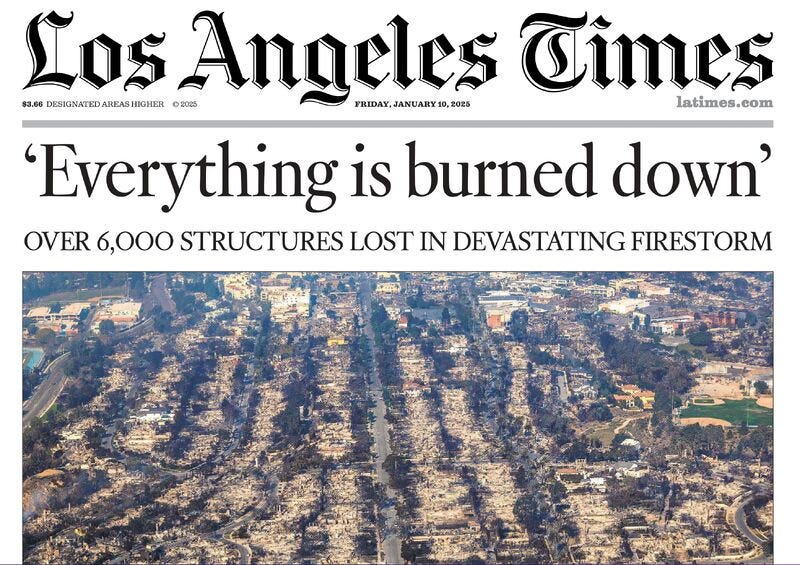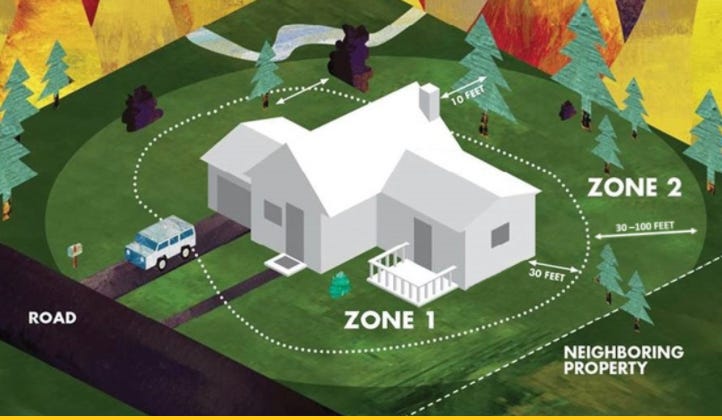Is Any Where Safe, Part 2
As with Hurricane Helene last fall, the Los Angeles wildfires highlight the fact that we keep putting people in harm's way -- and we're reluctant to do much of anything about it.
Thanks for reading The Future Of Where — I love heaering from you. Although this post is free, you can gain full access to The Future Of Where’s content now and in the future by signing up to be a paid subscriber!
For the past week, the entire nation has been both mesmerized and horrified by the enormous wildfires in Los Angeles, which so far have destroyed more than 10,000 houses and killed a dozen people. Though I’m watching from San Diego – 140 miles away from Pacific Palisades – I’m feeling this one deeply, because L.A. is a city I love and even once wrote a book about. And – as with Hurricane Helene last fall – the L.A. fires once again raise the question of whether any where is safe to live these days.
In a certain way, all these natural disasters are not surprising. It wasn’t surprising that Hurricane Helene hammered hurricane-prone Florida last fall, though it was somewhat surprising – as I wrote last fall – that it brought devastation to Asheville, 600 miles away. Similarly, it’s not surprising that a major wildfire hammered Pacific Palisades and Malibu, though the size and intensity of the fire was unprecedented. As Mike Davis wrote in his famous essay, “The Case For Letting Malibu Burn,” that area has been hit by fire repeatedly over the decades, requiring very expensive efforts to extinguish the fires.
So the question is not whether these horrific events are going to occur. They are going to occur. The question is what – if anything – we can do minimize the damage.
Disaster experts say there are three ways to deal with things like wildfires, floods, and hurricanes: avoidance, mitigation, and then battling the disaster when it occurs. All of them are expensive, but the expense comes at different points in the process and with different political risks.
Avoidance
Avoidance simply means what it says: Not placing people or structures in risky locations in the first place. But this would mean not putting any houses in the canyons in Los Angeles or near the bayous in Houston or, basically, anywhere in Florida. We can still avoid on the margins, but the damage is mostly done – and, in many cases, it’s still being done.
For example, despite the horrifying increase in wildfires in California – almost all of the worst wildfires in the state’s history have occurred in the last decade – county boards in rural parts of the state still routinely approve low-density subdivisions in high-fire-risk forests. There are several reasons for this. For one thing, people like to live in the forest and are willing to take the risk, just as people in Florida and the Outer Banks of North Carolina are willing to take the risk that a hurricane won’t hit them. Another factor is the simple fact that these elected officials are quite conservative and pro-property rights, so they are reluctant to tell landowners and developers they can’t build.
These two considerations are hard to change. But a third factor can be changed: The fact that if the density of a subdivision is low enough, Calfire will fight the wildfires and bear the cost. That means the local county officials don’t have to factor in the cost of fighting the fire. It’s not their problem. Though there’s not much we in California can do about high-risk areas where people already live, the state could certainly change this policy in order to discourage new development in risky areas.
Mitigation
Mitigation simply means reducing the risk as much as possible even while allowing people to live in risky areas. This is mostly where we are today. For example, after the disastrous wildfire in the Oakland Berkeley hills in the 1990s – which killed 25 people and destroyed 3,000 houses – the California state fire code was tightened so that homeowners in risky areas are no longer allowed to use flammable vegetation. And California state officials regularly advise people who live in risky areas to clear a defensible space around their house.
A typical plan for defensible space in a fire hazard area.
Of course, such mitigation measures don’t always work, especially in a high-wind situation such as Pacific Palisades, where burning embers were floating two or three miles before igniting additional houses.
And aggressive mitigation measures are sometimes so unpopular that they are not pursued. The Oakland fire was so devastating in part because the hillside neighborhoods designed in the early 20th Century had narrow, twisting roads with many parked cars (including some blocking fire hydrants). Revamping the street system – which would have facilitated both firefighting and evacuation – was proposed and never implemented because the people who lived in the hills did not want to change the character of their neighborhood, no matter what the risk.
A one-story house in Houson being raised afer Hurricane Harvey.
Similarly, proposed mitigation measures in Houston after Hurricane Harvey in 2017 also ran into political resistance. Homeowners who could afford it sought to protect themselves from future floods by raising their houses, sometimes by as much as 10 feet. (This has led to a weird pattern of one-story ranch houses being jacked up 10 feet with a garage underneath.) But when the Houston City Council considered requiring new houses to be built at a two-foot raise, landowners and developers resisted ferociously. In the wake of the most devastating flood in the city’s history, this mitigation required passed by a vote of 9-7.
Fighting and Recovering
Then there’s actually battling the disaster and shaping the recovery. I won’t go into detail about this here, but it is quite clear that Los Angeles’s fire departments were not – and perhaps could not have been, under any circumstances – prepared to fight a set of fires so destructive and devastating.
In all likelihood, the response to the Los Angeles fires will be similar to the response to the Oakland Hills fire. Fire codes will be further tightened to minimize the risk once a fire starts. A major overhaul of firefighting practices will probably take place. But the houses will be built in the same place on the same street grid, creating – in many ways – the same risk as before. Indeed, Los Angeles Mayor Karen Bass has already promised to “aggressively rebuild” the affluent Pacific Palisades neighborhood.
So the bottom line, we are where we are. We don’t have the political will or the money to keep people out of harm’s way or disrupt their desire to return to the life they had prior to the disaster. As some wag said once about the Federal Emergency Management Agency, we won’t spend $1 billion avoiding a problem of $10 billion mitigating it, but we are more than willing to spend $100 billion fighting it and cleaning up after it. All we can do is try to minimize the risk as much as possible – and hope that another disaster doesn’t strike very soon.





Thanks Bill for this insight.